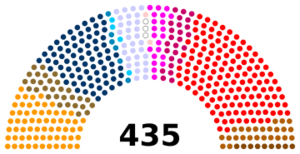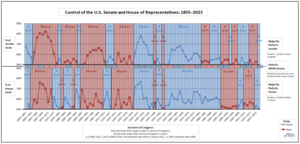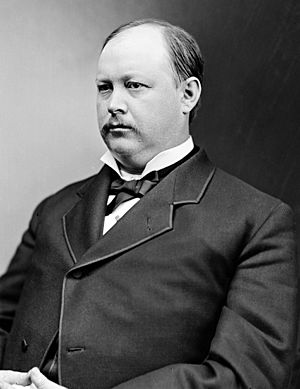United States House of Representatives facts for kids
Quick facts for kids United States House of Representatives |
|
|---|---|
| 119th United States Congress | |

Unofficial seal
|
|

Flag of the United States House of Representatives
|
|
| Type | |
| Type | |
|
Term limits
|
None |
| History | |
|
New session started
|
January 3, 2025 |
| Leadership | |
| Structure | |
| Seats | 435 voting members 6 non-voting members 218 for a majority |
 |
|
|
Political groups
|
Majority (219)
Minority (213)
Vacant (3)
|
|
Length of term
|
2 years |
| Elections | |
| Plurality voting in 46 states Varies in 4 states
|
|
|
Last election
|
November 5, 2024 |
|
Next election
|
November 3, 2026 |
| Redistricting | State legislatures or redistricting commissions, varies by state |
| Meeting place | |
 |
|
| House of Representatives Chamber United States Capitol Washington, D.C. United States of America |
|
The United States House of Representatives is an important part of the United States Congress. It works with the U.S. Senate to create laws for the country. The House is often called the "lower house," and the Senate is the "upper house." Together, they make sure new laws are fair and helpful.
Members of the House serve for two years. Each state gets a certain number of representatives based on its population. This number is counted by the United States census every ten years. Since 1913, there have been 435 voting members. Each state has at least one representative.
Besides the 435 voting members, there are also six non-voting members. These members represent places like the District of Columbia and U.S. territories. They can speak and work in committees but cannot vote on final laws. The House meets in the United States Capitol building in Washington, D.C.
Contents
History of the House of Representatives
How the House Began
Before the Constitution, the U.S. had a different government system. It was called the Articles of Confederation. Under this system, each state had equal power, which made it hard to get things done.
To create a stronger government, important leaders like James Madison and Alexander Hamilton met in Philadelphia in 1787. This meeting was called the Constitutional Convention. They wanted to improve the country's laws.
One big discussion was how Congress should be set up. Some states wanted representation based on population. This meant larger states would have more say. Smaller states wanted each state to have the same number of representatives. This would give them equal power, no matter their size.
They finally agreed on a plan called the Connecticut Compromise. This plan created two parts of Congress: the House, with members based on population, and the Senate, with an equal number of members from each state. The U.S. Constitution was approved in 1788.
The first House meeting happened on April 1, 1789, in New York City. Later, the capital moved to Philadelphia, and then to Washington, D.C.
The House in the 1800s
In the 1800s, the House and Senate often disagreed. One major issue was the practice of slavery. States in the North had more people, so they had more representatives in the House. But in the Senate, all states had equal representation.
Disagreements over slavery led to the American Civil War from 1861 to 1865. This war ended with the abolition of slavery in the United States.
After the Civil War, the Republican Party often had more members in the House. Later, both the Democratic Party and Republican Party took turns holding the majority.
Towards the end of the 1800s, the Speaker of the House became much more powerful. New leadership roles like the majority leader and minority leader were also created.
The House in the 1900s
In the early 1900s, Speaker Joseph Gurney Cannon had a lot of power. But in 1910, other members reduced some of these powers.
The Democratic Party held control of the House for many years, especially from 1933 to 1945. They also had control from 1955 to 1995. During this time, rules changed to give more power to party leaders and subcommittees.
In the 1990s, Republican Newt Gingrich became Speaker. He tried to pass many new laws and made big changes to how the House worked. He also helped Republicans gain control of the House in 1994.
The House in the 2000s
Republicans kept control of the House until 2006. Then, Democrats won control, and Nancy Pelosi became the first female Speaker.
In 2010, Republicans won back control of the House. This was a big change in power. Democrats took control again in 2018. In the 2022 elections, Republicans won a small majority and took back control of the House.
Members of the House
How Representatives are Chosen
The U.S. Constitution says that seats in the House are divided among the states based on their population. This population count comes from the census, which happens every ten years. Every state gets at least one representative, even if it has a small population.
The Constitution also says there shouldn't be more than one representative for every 30,000 people. Congress decided in 1911 to set the number of voting members at 435. This number has mostly stayed the same since then.
The District of Columbia and U.S. territories like Puerto Rico and Guam also have representatives. These are called non-voting delegates. They can speak in debates and work in committees. However, they cannot vote on the final passage of bills.
Drawing District Lines
States with more than one representative are divided into special areas called districts. Each district elects one representative. States usually redraw these district lines after each census. This makes sure each district has about the same number of people.
Sometimes, states draw district lines to favor one political party. This is called gerrymandering. Courts have allowed this in some cases, as long as it doesn't unfairly discriminate against racial or language minority voters.
Who Can Be a Representative?
To be a representative, a person must:
- Be at least 25 years old.
- Have been a U.S. citizen for at least seven years.
- Live in the state they represent at the time of the election.
Representatives usually live in the district they represent, but it's not a strict rule.
Elections for the House
Elections for representatives happen every two years. They are held on Election Day, which is the first Tuesday after the first Monday in November. Each representative serves a two-year term. There is no limit to how many terms they can serve.
Most states use a "first-past-the-post" system. This means the candidate with the most votes wins. Some states use different systems, like ranked-choice voting.
If a representative's seat becomes empty during their term, a special election is held to choose a new member.
Non-Voting Delegates
Historically, many U.S. territories have sent non-voting delegates to the House. Today, the District of Columbia and five U.S. territories each elect a delegate. These delegates can participate in debates and introduce bills. However, they cannot vote on the final passage of laws.
Terms and Rules for Members
Representatives serve for two-year terms. A term begins on January 3 after the election.
The House can remove a member with a two-thirds vote. This is called expulsion. Historically, members have been expelled for serious reasons, such as supporting states that tried to leave the Union during the Civil War. The House can also formally censure or reprimand members for less severe issues. This requires a simple majority vote and does not remove them from office.
House vs. Senate: What's Different?
The House and the Senate have different powers. For example, the Senate must approve presidential appointments and treaties.
The House has special powers too. It is the only body that can start bills about raising money (taxes). It can also impeach federal officials. Impeachment means formally accusing an official of wrongdoing. If no presidential candidate wins enough votes in the Electoral College, the House chooses the president.
Senators serve longer terms (six years) and represent entire states. House members serve two-year terms and represent smaller districts.
Pay and Benefits for Representatives
Salaries
Since December 2014, each representative earns $174,000 per year. The Speaker of the House and party leaders earn more. Their salaries can increase each year unless Congress votes against it. Representatives can receive retirement benefits after serving for five years.
Titles and How They're Called
Representatives are called "The Honorable" before their names. They are also known as representatives, congressmen, or congresswomen.
In the news, they are often identified by their party and state. For example, a representative might be called "D–California" (Democrat from California).
Retirement Benefits
Members of Congress are part of the Federal Employees Retirement System. This system provides a pension plan based on their years of service and salary. They can retire with full benefits at age 62 after five years of service, or earlier with more years of service.
Other Benefits
Representatives can deduct up to $3,000 per year for living expenses when they are away from their home district. They also have access to health benefits through special programs. The Office of the Attending Physician at the U.S. Capitol provides basic health care for a yearly fee.
Leaders and Staff in the House
Who Leads the House?
The political party with the most seats in the House is called the majority party. The party with fewer seats is the minority party.
The Speaker of the House is the main leader. The Speaker is chosen by the members of the House. They lead debates and help decide which bills are discussed. The Speaker is also second in line to become president after the vice president.
Each party also elects a floor leader. These are the majority leader and minority leader. They help guide their party's members on how to vote on laws.
There are also party whips. Whips work to make sure party members vote according to the party's wishes.
Other Important Officials
The House has other officials who are not members. The clerk keeps records and oversees other staff. The chief administrative officer handles the daily operations of the House, like payroll and food services.
The chaplain leads the House in prayer. The sergeant at arms is the chief law enforcement officer. They keep order and security in the House.
How the House Works
Daily Meetings
The House meets in the United States Capitol in Washington, D.C. The Speaker sits at the front of the chamber. Democrats usually sit on the left side, and Republicans on the right. Meetings are usually open to the public. They are also broadcast live on TV.
The House follows many rules and traditions. A special staff member carries the Mace of the United States House of Representatives to open each session. This mace is a symbol of the House's authority.
For the House to do business, a majority of its members must be present. This is called a quorum.
During debates, members must be recognized by the Speaker before they can speak. They must address the Speaker, not other members directly.
Making Laws
The House has rules for how it passes laws. The Rules Committee often sets rules for how long a bill can be debated and if changes (amendments) are allowed.
When debate ends, members vote. Sometimes they vote by voice, saying "yea" or "nay." Other times, they use an electronic system or colored cards to record their votes. Voting usually lasts about 15 minutes.
The Speaker can vote like other members. If there's a tie, the motion fails.
Committees and Groups

The House uses committees to review bills and oversee government agencies. Political parties choose which members serve on which committees.
The largest committee is the Committee of the Whole. It includes all members of the House. It can discuss and change bills, but it cannot pass them into law.
Most of the work is done by 20 standing committees. Each committee focuses on a specific topic, like agriculture or foreign affairs. These committees can stop bills from reaching a vote in the full House. They also investigate government departments.
Each committee is led by a chairman, who is always from the majority party. The chairman controls the committee's agenda. The most senior member of the minority party on a committee is called the Ranking Member.
How Laws are Made in the House
Most bills can start in either the House or the Senate. However, all bills about raising money (taxes) must start in the House. This is called the Origination Clause. The House also traditionally starts bills about spending money.
Even though the Senate cannot start these bills, it can still make changes to them or reject them.
For a bill to become a law, both the House and the Senate must pass the exact same version. If there are differences, a special group called a conference committee works to resolve them.
The president can veto a bill. This means they reject it. If the president vetoes a bill, both the House and Senate can vote again. If two-thirds of members in both houses vote for the bill, it becomes law even without the president's signature.
Checks and Balances with Other Branches
The Constitution gives the House and Senate ways to check the power of the president and other parts of the government.
The House can impeach federal officials, including the president. This means they can formally accuse them of serious wrongdoing. If the House votes to impeach, the Senate then holds a trial. A two-thirds vote in the Senate is needed to convict and remove an official from office.
In U.S. history, the House has impeached 17 officials. Only three U.S. presidents have been impeached: Andrew Johnson in 1868, Bill Clinton in 1998, and Donald Trump in 2019 and 2021. None of them were removed from office by the Senate.
If no presidential candidate wins a majority of votes in the Electoral College, the House gets to choose the president. Each state delegation gets one vote. This has only happened twice in U.S. history: in 1800 and 1824.
See also
 In Spanish: Cámara de Representantes de los Estados Unidos para niños
In Spanish: Cámara de Representantes de los Estados Unidos para niños
- List of current members of the United States House of Representatives
- 2024 United States House of Representatives elections
- List of current United States representatives
- List of portraits in the United States House of Representatives collection (A–J)
- Party divisions of United States Congresses
- Seniority in the United States House of Representatives
- Third-party members of the United States House of Representatives
- U.S. representative bibliography (congressional memoirs)
- Women in the United States House of Representatives




